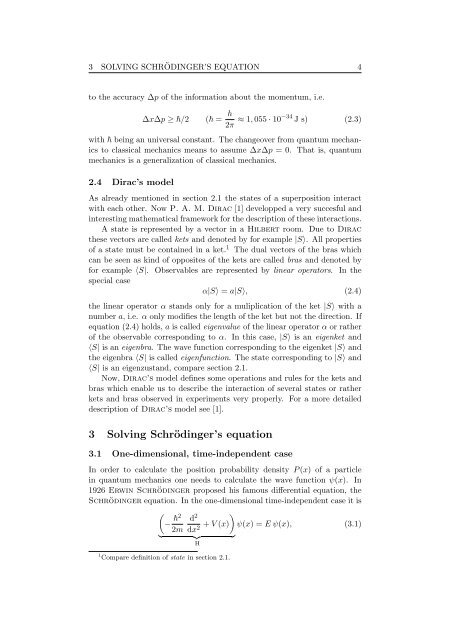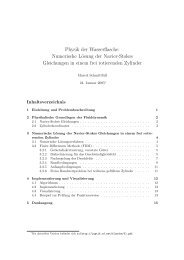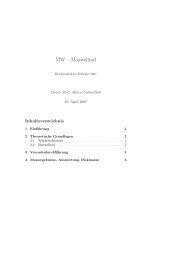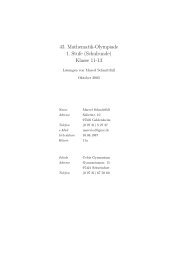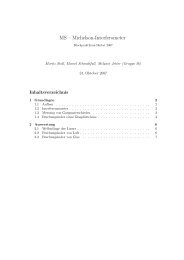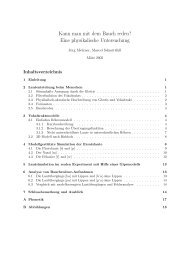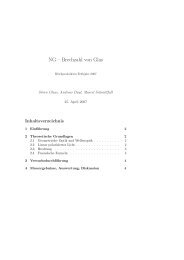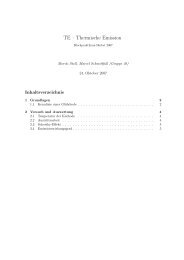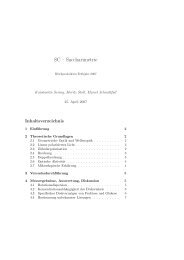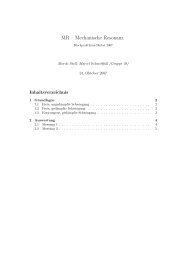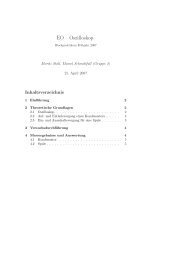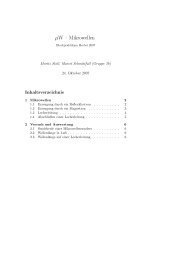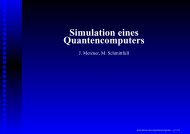JavaPsi - Simulating and Visualizing Quantum Mechanics (english)
JavaPsi - Simulating and Visualizing Quantum Mechanics (english)
JavaPsi - Simulating and Visualizing Quantum Mechanics (english)
Create successful ePaper yourself
Turn your PDF publications into a flip-book with our unique Google optimized e-Paper software.
3 SOLVING SCHRÖDINGER’S EQUATION 4<br />
to the accuracy ∆p of the information about the momentum, i.e.<br />
∆x∆p ≥ /2 ( = h<br />
2π ≈ 1, 055 · 10−34 J s) (2.3)<br />
with being an universal constant. The changeover from quantum mechanics<br />
to classical mechanics means to assume ∆x∆p = 0. That is, quantum<br />
mechanics is a generalization of classical mechanics.<br />
2.4 Dirac’s model<br />
As already mentioned in section 2.1 the states of a superposition interact<br />
with each other. Now P. A. M. Dirac [1] developped a very succesful <strong>and</strong><br />
interesting mathematical framework for the description of these interactions.<br />
A state is represented by a vector in a Hilbert room. Due to Dirac<br />
these vectors are called kets <strong>and</strong> denoted by for example |S〉. All properties<br />
of a state must be contained in a ket. 1 The dual vectors of the bras which<br />
can be seen as kind of opposites of the kets are called bras <strong>and</strong> denoted by<br />
for example 〈S|. Observables are represented by linear operators. In the<br />
special case<br />
α|S〉 = a|S〉, (2.4)<br />
the linear operator α st<strong>and</strong>s only for a muliplication of the ket |S〉 with a<br />
number a, i.e. α only modifies the length of the ket but not the direction. If<br />
equation (2.4) holds, a is called eigenvalue of the linear operator α or rather<br />
of the observable corresponding to α. In this case, |S〉 is an eigenket <strong>and</strong><br />
〈S| is an eigenbra. The wave function corresponding to the eigenket |S〉 <strong>and</strong><br />
the eigenbra 〈S| is called eigenfunction. The state corresponding to |S〉 <strong>and</strong><br />
〈S| is an eigenzust<strong>and</strong>, compare section 2.1.<br />
Now, Dirac’s model defines some operations <strong>and</strong> rules for the kets <strong>and</strong><br />
bras which enable us to describe the interaction of several states or rather<br />
kets <strong>and</strong> bras observed in experiments very properly. For a more detailed<br />
description of Dirac’s model see [1].<br />
3 Solving Schrödinger’s equation<br />
3.1 One-dimensional, time-independent case<br />
In order to calculate the position probability density P (x) of a particle<br />
in quantum mechanics one needs to calculate the wave function ψ(x). In<br />
1926 Erwin Schrödinger proposed his famous differential equation, the<br />
Schrödinger equation. In the one-dimensional time-independent case it is<br />
<br />
− 2 d<br />
2m<br />
2 <br />
+ V (x) ψ(x) = E ψ(x), (3.1)<br />
dx2 <br />
H<br />
1 Compare definition of state in section 2.1.


